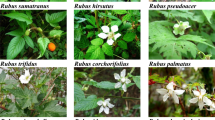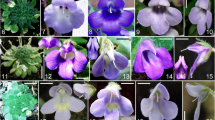Abstract
Veratrum (Melanthiaceae) comprises ca. 27 species with highly variable morphology. This study aims to construct the molecular phylogeny of this genus to infer its floral evolution and historical biogeography, which have not been examined in detail before. Maximum parsimony, maximum likelihood, and Bayesian analyses were performed on the separate and combined ITS, trnL-F, and atpB-rbcL sequences to reconstruct the phylogenetic tree of the genus. All Veratrum taxa formed a monophyletic group, within which two distinct clades were distinguished: species with white-to-green perianth formed one highly supported clade, and the species with black-purple perianth constituted another highly supported clade. Phylogenetic inference on flower color evolution suggested that white-to-green perianth was a plesiomorphic state and black-purple perianth was apomorphic for Veratrum. When species distribution areas were traced as a multi-state character, parsimonious optimization inferred that Veratrum possibly originated in East Asia. Our study confirmed previous phylogenetic and taxonomic suggestions on this genus and provided a typical example of plant radiation across the Northern Hemisphere.
Similar content being viewed by others
References
Akaike H. (1974). A new look at the statistical model identification. IEEE T. Automat. Cont. 19: 716–723
Baker J. G. (1880). A synopsis of the Colchicaceae and the aberrant tribes of Liliaceae. Bot. J. Linn. Soc. 17: 405–410
Bodkin N. L. (1978). A revision of North American Melanthium L. (Liliaceae). Ph.D. dissertation. University of Maryland, College Park
Chase M. W. and Hills H. G. (1991). Silica gel: an ideal material for field preservation of leaf samples for DNA studies. Taxon 40: 215–220
Chen X. Q., Takahashi H. (2000) Veratrum. In: Flora of China Editorial Committee (ed.) Flora of China. Science Press, Beijing, China: 82–85.
Chiang T. Y., Schaal B. A. and Peng C. I. (1998). Universal primers for amplification and sequencing a noncoding spacer between the atpB and rbcL genes of chloroplast DNA. Bot. Bul. Acad. Sin. 39: 245–250
Darlu P. and Lecointre G. (2002). When does the incongruence length difference test fail?. Molec. Biol. Evol. 19: 432–437
Deam C. C. (1940) Flora of Indiana. Department of Conservation, Division of Forestry, Indianapolis, Indiana: 307–308.
DeBry R. W. and Olmstead R. G. (2000). A simulation study of reduced tree-search effort in bootstrap resampling analysis. Syst. Biol. 49: 171–179
Dolphin K., Belshaw R., Orme C. D. L. and Quicke D. L. J. (2000). Noise and incongruence: interpreting results of the incongruence length difference test. Molec. Phylogenet. Evol. 17: 401–406
Dowton M. and Austin A. D. (2002). Increased congruence does not necessarily indicate increased phylogenetic accuracy - the behavior of the incongruence length difference test in mixed-model analyses. Syst. Biol. 51: 19–31
Farris J. S., Källersjö M., Kluge A. G. and Bult C. (1995). Constructing a significance test for incongruence. Syst. Biol. 44: 570–572
Felsenstein J. (1985). Confidence limits on phylogenies: an approach using the bootstrap. Evolution 39: 783–791
Hodges S. A., Whittall J. B., Fulton M. and Yang J. Y. (2002). Genetics of floral traits influencing reproductive isolation between Aquilegia formosa and Aquilegia pubescens. Amer. Naturalist 159: S51–S60
Hong D. Y. (1993). Eastern Asian-North American disjunctions and their biological significance. Cathaya 5: 1–39
Huelsenbeck J. P. and Ronquist F. (2001). MRBAYES: Bayesian inference of phylogenetic trees. Bioinformatics 17: 754–755
Ji Z. H. (1980) Veratrum. In: Flora of China Editorial Committee (ed.) Flora reipublicae popularis sinicae. Science Press, Beijing, pp. 19–30 (in Chinese).
Kleijn D. and Steinger T. (2002). Contrasting effects of grazing and hay cutting on the spatial and genetic population structure of Veratrum album, an unpalatable, long-lived, clonal plant species. J. Ecol. 90: 360–370
Knuth P. (1909). Handbook of flower pollination. Clarendon Press, Oxford
Liao W. J., Song Q. F. and Zhang D. Y. (2006). Pollen and resource limitation in Veratrum nigrum (Liliaceae), an andromonoecious herb. J. Integr. Pl. Biol. 48: 1401–1408
Maddison W. P. and Maddison D. R. (1992). MacClade: Analysis of phylogeny and character evolution, version 3.0. Sinauer, Sunderland
McKenna M. C. (1975). Fossil mammals and early Eocene North Atlantic land continuity. Ann. Missouri Bot. Gard. 62: 335–353
Miller R. E., Rausher M. D. and Manos P. S. (1999). Phylogenetic systematics of Ipomoea (Convolvulaceae) based on ITS and waxy sequences. Syst. Bot. 24: 209–227
Novacek M. J. (1999). 100 million years of land vertebrate evolution: the Cretaceous-early Tertiary transition. Ann. Missouri Bot. Gard. 86: 230–258
Nylander J. A. A. (2004) MrModeltest v2. Program distributed by the author. Uppsala University, Evolutionary Biology Centre, Uppsala.
Richardson J. E., Pennington R. T., Pennington T. D. and Hollingsworth P. M. (2001). Rapid diversification of a species rich genus of Neotropical rain forest trees. Science 293: 2242–2245
Robertson C. (1896). Flowers and Insects. XVI. Bot. Gaz. 21: 266–274
Ronquist F. and Huelsenbeck J. P. (2003). MrBayes 3: Bayesian phylogenetic inference under mixed models. Bioinformatics 19: 1572–1574
Swofford D. L. (2000). PAUP*. Phylogenetic analysis using parsimony (* and other methods). Version 4. Sinauer Associates, Sunderland
Taberlet P., Gielly L., Pautou G. and Bouvet J. (1991). Universal primers for amplification of three non-coding regions of chloroplast DNA. Pl. Molec. Biol. 17: 1105–1109
Thompson J. D., Gibson T. J., Plewniak F., Jeanmougin F. and Higgins D. G. (1997). The ClustalX windows interface: flexible strategies for multiple sequence alignment aided by quality analysis tools. Nucleic Acids Res. 24: 4876–4882
Tiffney B. H. (1985a). The Eocene North Atlantic land bridge: its importance in Tertiary and modern phytogeography of the northern hemisphere. J. Arnold Arbor. 66: 243–273
Tiffney B. H. (1985b). Perspectives on the origin of the floristic similarity between eastern Asia and eastern North America. J. Arnold Arbor. 66: 73–94
Waser N. (1983). The adaptive nature of floral traits: ideas and evidence. In: Real, L. (eds) Pollination biology, pp 241–285. Academic Press, New York
White T. J., Bruns T., Lee S. and Taylor J. (1990). Amplification and direct sequencing of fungal ribosomal RNA genes for phylogenetics. In: Innis, M., Gelfand, D., Sninsky, J., and White, T. (eds) PCR protocols: A guide to methods and applications, pp 315–322. Academic Press, San Diego
Wilkin P. (1995). A new species of Ipomoea (Convolvulaceae) from Mexico State, Mexico and its evolution. Kew Bull. 50: 93–102
Wolfe J. A. (1972). An interpretation of Alaskan Tertiary floras. In: Graham, A. (eds) Floristics and paleofloristics of Asia and Eastern North America, pp 201–233. Elsevier, New York
Wolfe J. A. (1975). Some aspects of plant geography of the Northern Hemisphere during the Late Cretaceous and Tertiary. Ann. Missouri Bot. Gard. 62: 264–179
Wulff E. V. (1943). An introduction to historical plant geography. Chronica Botanica, Waltham
Yoder A. D., Irwin J. A. and Payseur B. A. (2001). Failure of the ILD to determine data combinability for slow loris phylogeny. Syst. Biol. 50: 408–424
Yuan Y. M., Wohlhauser S., Möller M., Chassot P., Mansion G., Grant J., Kupfer P. and Klackenberg J. (2003). Monophyly and relationships of the tribe Exaceae (Gentianaceae) inferred from nuclear ribosomal and chloroplast DNA sequences. Molec. Phylogenet. Evol. 28: 500–517
Zomlefer W. B. (1997). The genera of Melanthiaceae in the southeastern United States. Harvard Pap. Bot. 2: 133–177
Zomlefer W. B., Whitten W. M., Williams N. H. and Judd W. S. (2003). An overview of Veratrum s.1. (Liliales : Melanthiaceae) and an infrageneric phylogeny based on ITS sequence data. Syst. Bot. 28: 250–269
Zomlefer W. B., Williams N. H., Whitten W. M. and Judd W. S. (2001). Generic circumscription and relationships in the tribe Melanthieae (Liliales, Melanthiaceae), with emphasis on Zigadenus: Evidence from ITS and trnL-F sequence data. Amer. J. Bot. 88: 1657–1669
Author information
Authors and Affiliations
Corresponding author
Rights and permissions
About this article
Cite this article
Liao, WJ., Yuan, YM. & Zhang, DY. Biogeography and evolution of flower color in Veratrum (Melanthiaceae) through inference of a phylogeny based on multiple DNA markers. Plant Syst. Evol. 267, 177–190 (2007). https://doi.org/10.1007/s00606-007-0528-z
Received:
Accepted:
Published:
Issue Date:
DOI: https://doi.org/10.1007/s00606-007-0528-z




